Network Security: ATM Protection and Biometric Authentication Systems
VerifiedAdded on 2023/06/14
|7
|1209
|292
Homework Assignment
AI Summary
This assignment delves into various aspects of network security, focusing on ATM systems and biometric authentication. It addresses the critical factors for ATM security, including confidentiality, integrity, and availability, providing examples and highlighting their importance. The assignment also calculates the number of possibilities a thief might try to detect a PIN and discusses security issues associated with biometric systems, such as data breaches and illegal access, suggesting solutions like user awareness and multimodal biometrics. Furthermore, it differentiates between false positives and false negatives in biometric authentication, illustrating their impact with real-world examples. Finally, the assignment touches upon transposition as a cryptographic method for text encryption. Desklib provides access to similar solved assignments and study tools for students.
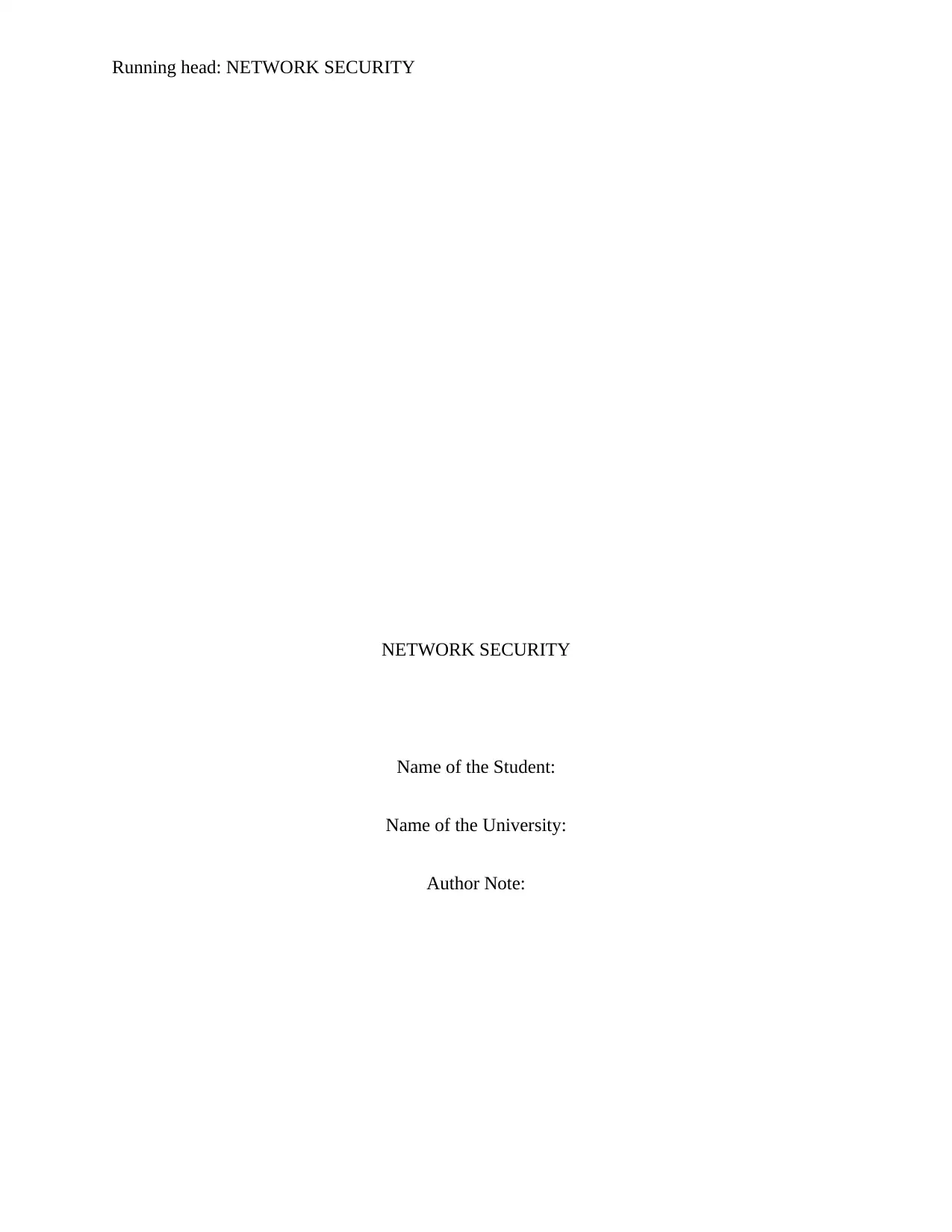
Running head: NETWORK SECURITY
NETWORK SECURITY
Name of the Student:
Name of the University:
Author Note:
NETWORK SECURITY
Name of the Student:
Name of the University:
Author Note:
Paraphrase This Document
Need a fresh take? Get an instant paraphrase of this document with our AI Paraphraser
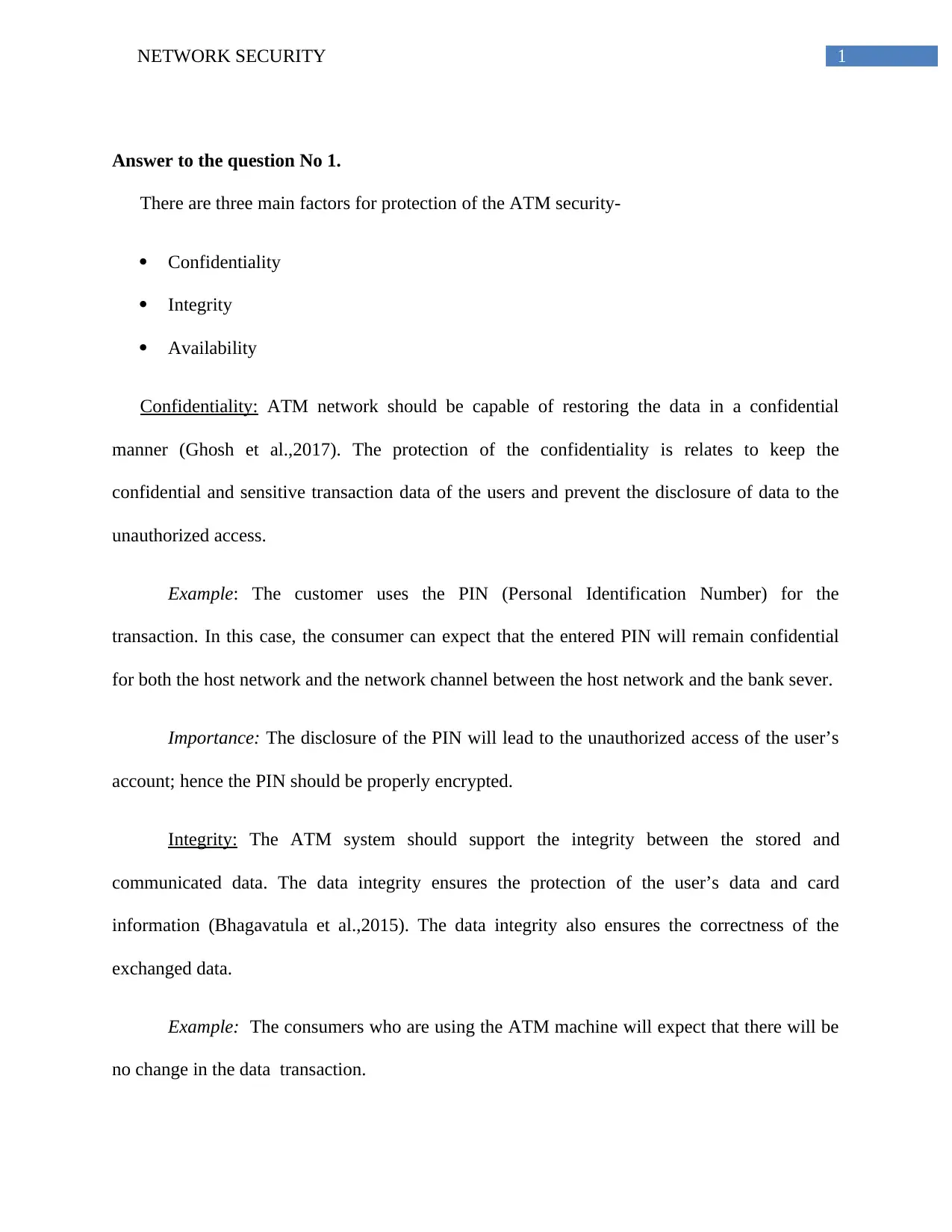
1NETWORK SECURITY
Answer to the question No 1.
There are three main factors for protection of the ATM security-
Confidentiality
Integrity
Availability
Confidentiality: ATM network should be capable of restoring the data in a confidential
manner (Ghosh et al.,2017). The protection of the confidentiality is relates to keep the
confidential and sensitive transaction data of the users and prevent the disclosure of data to the
unauthorized access.
Example: The customer uses the PIN (Personal Identification Number) for the
transaction. In this case, the consumer can expect that the entered PIN will remain confidential
for both the host network and the network channel between the host network and the bank sever.
Importance: The disclosure of the PIN will lead to the unauthorized access of the user’s
account; hence the PIN should be properly encrypted.
Integrity: The ATM system should support the integrity between the stored and
communicated data. The data integrity ensures the protection of the user’s data and card
information (Bhagavatula et al.,2015). The data integrity also ensures the correctness of the
exchanged data.
Example: The consumers who are using the ATM machine will expect that there will be
no change in the data transaction.
Answer to the question No 1.
There are three main factors for protection of the ATM security-
Confidentiality
Integrity
Availability
Confidentiality: ATM network should be capable of restoring the data in a confidential
manner (Ghosh et al.,2017). The protection of the confidentiality is relates to keep the
confidential and sensitive transaction data of the users and prevent the disclosure of data to the
unauthorized access.
Example: The customer uses the PIN (Personal Identification Number) for the
transaction. In this case, the consumer can expect that the entered PIN will remain confidential
for both the host network and the network channel between the host network and the bank sever.
Importance: The disclosure of the PIN will lead to the unauthorized access of the user’s
account; hence the PIN should be properly encrypted.
Integrity: The ATM system should support the integrity between the stored and
communicated data. The data integrity ensures the protection of the user’s data and card
information (Bhagavatula et al.,2015). The data integrity also ensures the correctness of the
exchanged data.
Example: The consumers who are using the ATM machine will expect that there will be
no change in the data transaction.
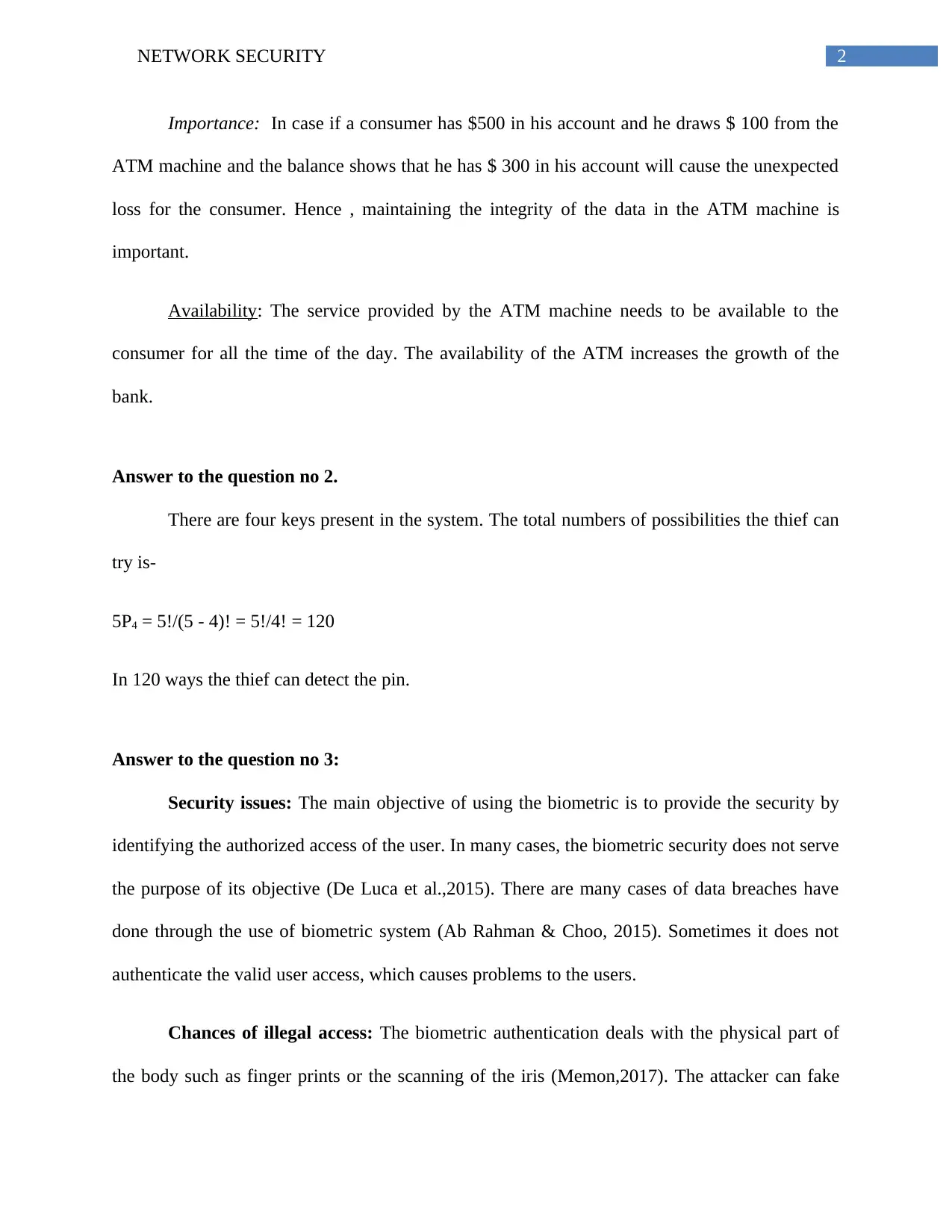
2NETWORK SECURITY
Importance: In case if a consumer has $500 in his account and he draws $ 100 from the
ATM machine and the balance shows that he has $ 300 in his account will cause the unexpected
loss for the consumer. Hence , maintaining the integrity of the data in the ATM machine is
important.
Availability: The service provided by the ATM machine needs to be available to the
consumer for all the time of the day. The availability of the ATM increases the growth of the
bank.
Answer to the question no 2.
There are four keys present in the system. The total numbers of possibilities the thief can
try is-
5P4 = 5!/(5 - 4)! = 5!/4! = 120
In 120 ways the thief can detect the pin.
Answer to the question no 3:
Security issues: The main objective of using the biometric is to provide the security by
identifying the authorized access of the user. In many cases, the biometric security does not serve
the purpose of its objective (De Luca et al.,2015). There are many cases of data breaches have
done through the use of biometric system (Ab Rahman & Choo, 2015). Sometimes it does not
authenticate the valid user access, which causes problems to the users.
Chances of illegal access: The biometric authentication deals with the physical part of
the body such as finger prints or the scanning of the iris (Memon,2017). The attacker can fake
Importance: In case if a consumer has $500 in his account and he draws $ 100 from the
ATM machine and the balance shows that he has $ 300 in his account will cause the unexpected
loss for the consumer. Hence , maintaining the integrity of the data in the ATM machine is
important.
Availability: The service provided by the ATM machine needs to be available to the
consumer for all the time of the day. The availability of the ATM increases the growth of the
bank.
Answer to the question no 2.
There are four keys present in the system. The total numbers of possibilities the thief can
try is-
5P4 = 5!/(5 - 4)! = 5!/4! = 120
In 120 ways the thief can detect the pin.
Answer to the question no 3:
Security issues: The main objective of using the biometric is to provide the security by
identifying the authorized access of the user. In many cases, the biometric security does not serve
the purpose of its objective (De Luca et al.,2015). There are many cases of data breaches have
done through the use of biometric system (Ab Rahman & Choo, 2015). Sometimes it does not
authenticate the valid user access, which causes problems to the users.
Chances of illegal access: The biometric authentication deals with the physical part of
the body such as finger prints or the scanning of the iris (Memon,2017). The attacker can fake
⊘ This is a preview!⊘
Do you want full access?
Subscribe today to unlock all pages.

Trusted by 1+ million students worldwide
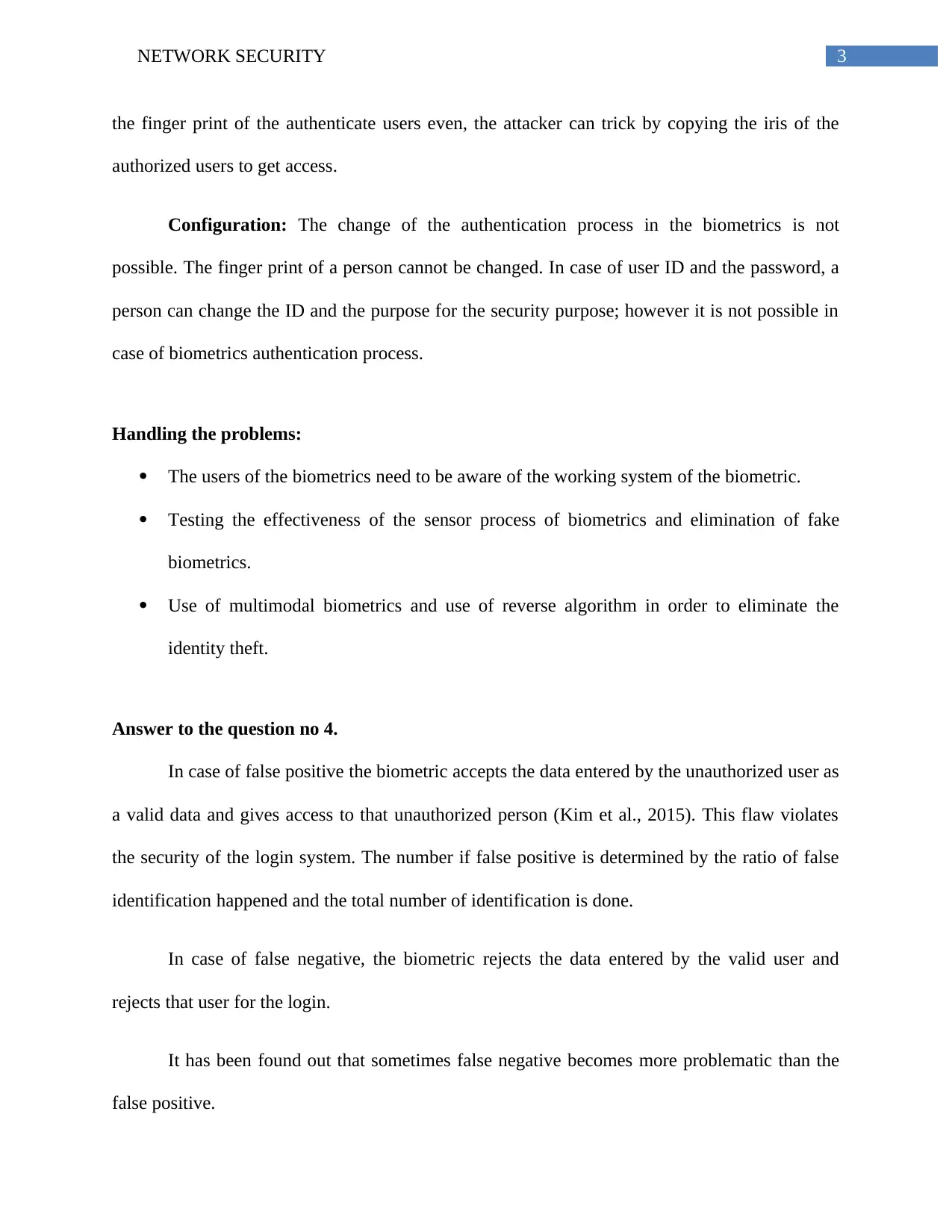
3NETWORK SECURITY
the finger print of the authenticate users even, the attacker can trick by copying the iris of the
authorized users to get access.
Configuration: The change of the authentication process in the biometrics is not
possible. The finger print of a person cannot be changed. In case of user ID and the password, a
person can change the ID and the purpose for the security purpose; however it is not possible in
case of biometrics authentication process.
Handling the problems:
The users of the biometrics need to be aware of the working system of the biometric.
Testing the effectiveness of the sensor process of biometrics and elimination of fake
biometrics.
Use of multimodal biometrics and use of reverse algorithm in order to eliminate the
identity theft.
Answer to the question no 4.
In case of false positive the biometric accepts the data entered by the unauthorized user as
a valid data and gives access to that unauthorized person (Kim et al., 2015). This flaw violates
the security of the login system. The number if false positive is determined by the ratio of false
identification happened and the total number of identification is done.
In case of false negative, the biometric rejects the data entered by the valid user and
rejects that user for the login.
It has been found out that sometimes false negative becomes more problematic than the
false positive.
the finger print of the authenticate users even, the attacker can trick by copying the iris of the
authorized users to get access.
Configuration: The change of the authentication process in the biometrics is not
possible. The finger print of a person cannot be changed. In case of user ID and the password, a
person can change the ID and the purpose for the security purpose; however it is not possible in
case of biometrics authentication process.
Handling the problems:
The users of the biometrics need to be aware of the working system of the biometric.
Testing the effectiveness of the sensor process of biometrics and elimination of fake
biometrics.
Use of multimodal biometrics and use of reverse algorithm in order to eliminate the
identity theft.
Answer to the question no 4.
In case of false positive the biometric accepts the data entered by the unauthorized user as
a valid data and gives access to that unauthorized person (Kim et al., 2015). This flaw violates
the security of the login system. The number if false positive is determined by the ratio of false
identification happened and the total number of identification is done.
In case of false negative, the biometric rejects the data entered by the valid user and
rejects that user for the login.
It has been found out that sometimes false negative becomes more problematic than the
false positive.
Paraphrase This Document
Need a fresh take? Get an instant paraphrase of this document with our AI Paraphraser
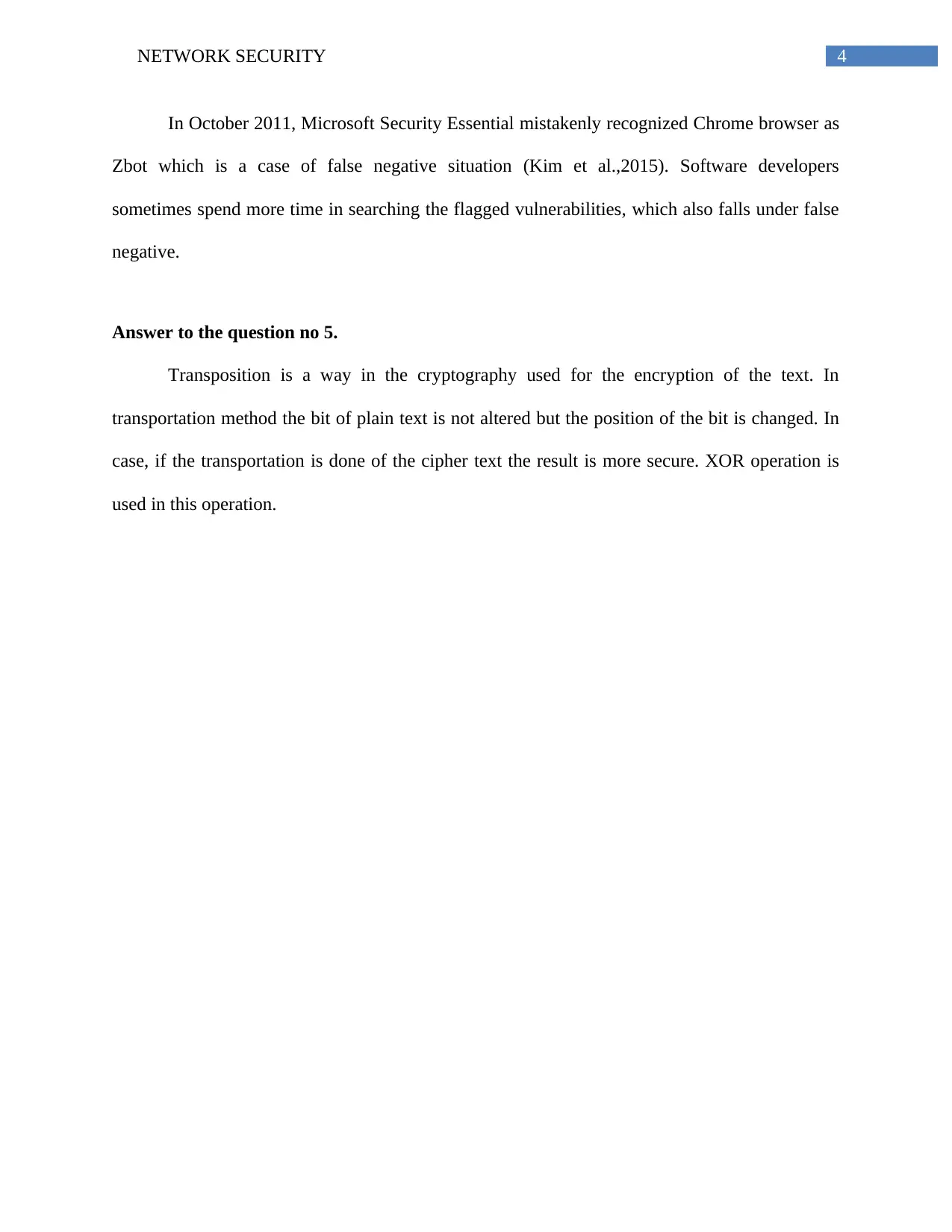
4NETWORK SECURITY
In October 2011, Microsoft Security Essential mistakenly recognized Chrome browser as
Zbot which is a case of false negative situation (Kim et al.,2015). Software developers
sometimes spend more time in searching the flagged vulnerabilities, which also falls under false
negative.
Answer to the question no 5.
Transposition is a way in the cryptography used for the encryption of the text. In
transportation method the bit of plain text is not altered but the position of the bit is changed. In
case, if the transportation is done of the cipher text the result is more secure. XOR operation is
used in this operation.
In October 2011, Microsoft Security Essential mistakenly recognized Chrome browser as
Zbot which is a case of false negative situation (Kim et al.,2015). Software developers
sometimes spend more time in searching the flagged vulnerabilities, which also falls under false
negative.
Answer to the question no 5.
Transposition is a way in the cryptography used for the encryption of the text. In
transportation method the bit of plain text is not altered but the position of the bit is changed. In
case, if the transportation is done of the cipher text the result is more secure. XOR operation is
used in this operation.
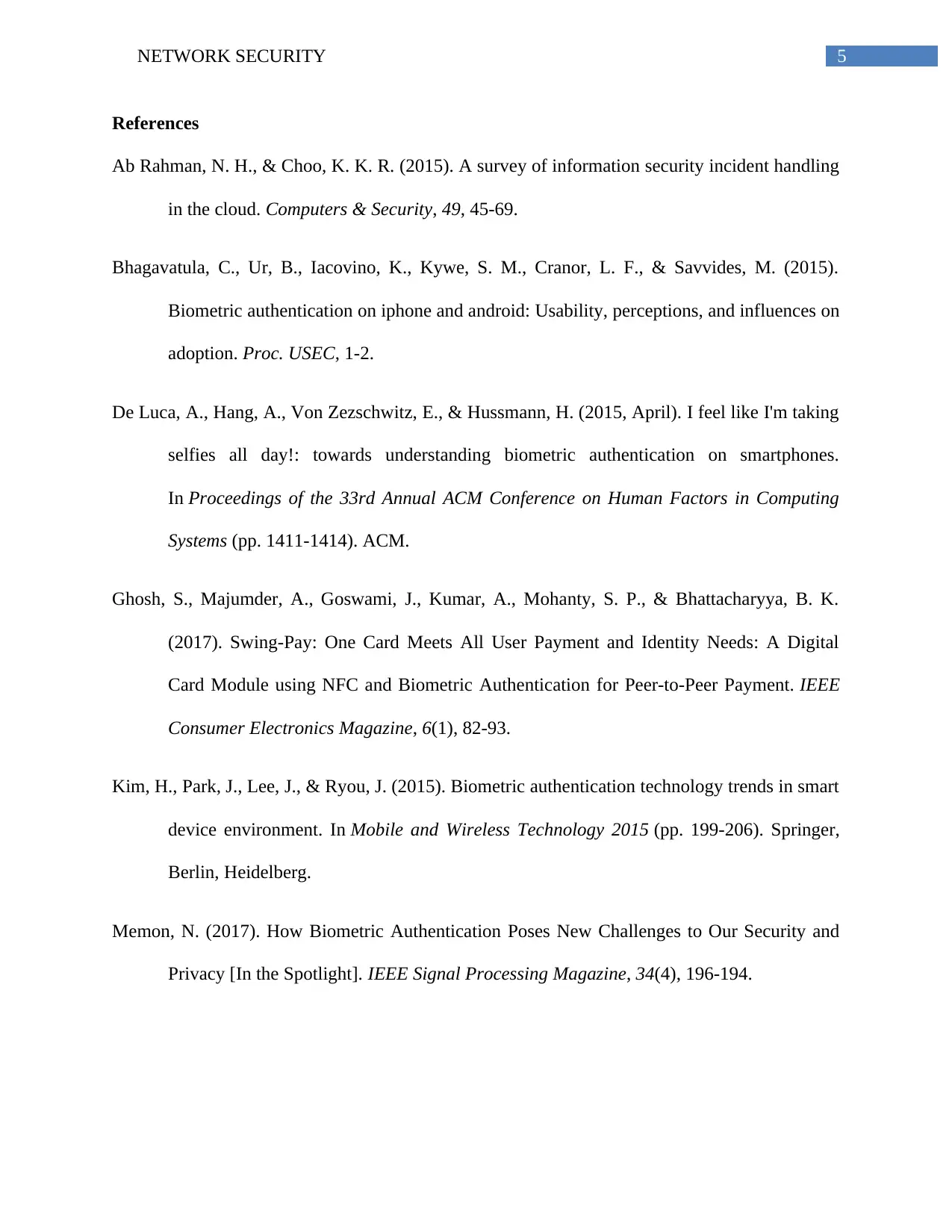
5NETWORK SECURITY
References
Ab Rahman, N. H., & Choo, K. K. R. (2015). A survey of information security incident handling
in the cloud. Computers & Security, 49, 45-69.
Bhagavatula, C., Ur, B., Iacovino, K., Kywe, S. M., Cranor, L. F., & Savvides, M. (2015).
Biometric authentication on iphone and android: Usability, perceptions, and influences on
adoption. Proc. USEC, 1-2.
De Luca, A., Hang, A., Von Zezschwitz, E., & Hussmann, H. (2015, April). I feel like I'm taking
selfies all day!: towards understanding biometric authentication on smartphones.
In Proceedings of the 33rd Annual ACM Conference on Human Factors in Computing
Systems (pp. 1411-1414). ACM.
Ghosh, S., Majumder, A., Goswami, J., Kumar, A., Mohanty, S. P., & Bhattacharyya, B. K.
(2017). Swing-Pay: One Card Meets All User Payment and Identity Needs: A Digital
Card Module using NFC and Biometric Authentication for Peer-to-Peer Payment. IEEE
Consumer Electronics Magazine, 6(1), 82-93.
Kim, H., Park, J., Lee, J., & Ryou, J. (2015). Biometric authentication technology trends in smart
device environment. In Mobile and Wireless Technology 2015 (pp. 199-206). Springer,
Berlin, Heidelberg.
Memon, N. (2017). How Biometric Authentication Poses New Challenges to Our Security and
Privacy [In the Spotlight]. IEEE Signal Processing Magazine, 34(4), 196-194.
References
Ab Rahman, N. H., & Choo, K. K. R. (2015). A survey of information security incident handling
in the cloud. Computers & Security, 49, 45-69.
Bhagavatula, C., Ur, B., Iacovino, K., Kywe, S. M., Cranor, L. F., & Savvides, M. (2015).
Biometric authentication on iphone and android: Usability, perceptions, and influences on
adoption. Proc. USEC, 1-2.
De Luca, A., Hang, A., Von Zezschwitz, E., & Hussmann, H. (2015, April). I feel like I'm taking
selfies all day!: towards understanding biometric authentication on smartphones.
In Proceedings of the 33rd Annual ACM Conference on Human Factors in Computing
Systems (pp. 1411-1414). ACM.
Ghosh, S., Majumder, A., Goswami, J., Kumar, A., Mohanty, S. P., & Bhattacharyya, B. K.
(2017). Swing-Pay: One Card Meets All User Payment and Identity Needs: A Digital
Card Module using NFC and Biometric Authentication for Peer-to-Peer Payment. IEEE
Consumer Electronics Magazine, 6(1), 82-93.
Kim, H., Park, J., Lee, J., & Ryou, J. (2015). Biometric authentication technology trends in smart
device environment. In Mobile and Wireless Technology 2015 (pp. 199-206). Springer,
Berlin, Heidelberg.
Memon, N. (2017). How Biometric Authentication Poses New Challenges to Our Security and
Privacy [In the Spotlight]. IEEE Signal Processing Magazine, 34(4), 196-194.
⊘ This is a preview!⊘
Do you want full access?
Subscribe today to unlock all pages.

Trusted by 1+ million students worldwide

6NETWORK SECURITY
1 out of 7
Related Documents
Your All-in-One AI-Powered Toolkit for Academic Success.
+13062052269
info@desklib.com
Available 24*7 on WhatsApp / Email
![[object Object]](/_next/static/media/star-bottom.7253800d.svg)
Unlock your academic potential
Copyright © 2020–2025 A2Z Services. All Rights Reserved. Developed and managed by ZUCOL.



